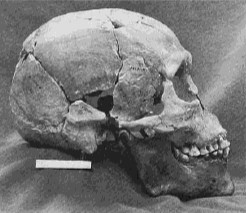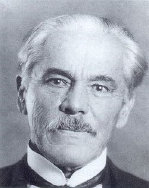


Contact
Home
Hoaxes & Pranks: Monster Hunters
PREHISTORIC RUIN IN MEXICO.
PYRAMIDS AND GREAT CITIES.
Chronicle (Adelaide, SA)
Date: July 26, 1924
Page Number: 69
Science recently has become increasingly interested in the speculative possibility that the Western Hemisphere has for more than four
centuries been miscalled the New World, and that it, rather than the Eastern Hemisphere, first cradled civilisation. The newly-found
ruins of a great city and a high pyramid of the first Mayan Empire, discovered in the British Honduran jungle by a British expedition
headed by Mr. Mitchell Hedges, is likely to yield new and interesting evidence.
The expedition (writes the
New York correspondent of the Manchester "Guardian") was conducted from a base near Belize, capital of British Honduras. Ruins of
great stone structures scattered over hundreds of acres, together with a pyramid more than 300 feet high, were found. Much of the
dead city, hidden for many centuries, was covered with jungle growth. Jungle beasts, birds, and snakes had been its long. No competent
archaeologist has as yet made any estimate as to its age. It is far inland and distant from any modern path or trail.
Limited explorations in recent years have uncovered other ancient Mayan cities and pyramids in Yucatan. The prehistoric city of Teotihuacan,
less than 40 miles from Mexico city, has been only superficially explored. Together with its pyramids of the sun and the moon, Teotihuacan
is one of the most remarkable archaeological finds in all history. The ruins of one ancient city were found to be superimposed upon
the ruins of another. Competent archaeologists believe it to be possible that this submerged city may yield clues to a civilisation
in Mexico and the Central Americas antedating that of the Valley of the Nile.
A Visit to the Ruins.
The Teotihuacan
pyramids are believed to have been built centuries after the building of the sub-merged city at their base. Estimates of the antiquity
of the upper city place it as possibly as many as three thousand years before the Christian era. No archaeologist is willing to hazard
any estimate as yet as to the antiquity of the lower ruins.
Northward, in Southern California, near Los Angeles,
in a territory formerly Mexican, has been found recently the skull of a man who, according to his geological placement, must have
lived 500,000 years ago, greatly antedating the estimated age of the Piltdown and the Heidelberg men. This discovery is being investigated
by the Carnegie and the Smitlisonian Institutions; scientific men connected with these institutions, including Professor Merriam of
the Carnegie Institution, an archaeologist of high standing, are already convinced that a new find of great importance to anthropology
has been unearthed.
Dr. Manuel Gamio, chief of the Department of Anthropology of the Mexican Government, had
a staff correspondent of the New York "World" conducted to Teotihuacan last summer. Dr. Gamio had suffered a broken hip from falling
off a horse, and was not himself able to go, but he sent a member of his staff. The doctor is highly regarded by such authorities
as Dr. Ales Hrdlicka, the Smithsonian anthropologist, who aims himself to go to Mexico to carry forward preliminary explorations and
studies he made there several years ago. When the correspondent left Washington for Mexico. Dr. Hrdlicka advised him to call upon
Dr. Gamio. He found the Mexican anthropologist chary of making strong claims and inclined to postpone estimates until more evidence
has been studied. In this he is hampered by the poverty of the Mexican Government, and the Government's unwillingness to turn over
to aliens complete control of their archaeological fields.
British and American explorers have been permitted
to do a limited amount of field work amd the ruins of the Mayan and other American-Indian civilisations. They have been handicapped,
as have Mexican investigators, by inability so far to decipher the more important hieroglyphics on temples and other buildings. Much
more will be known when headway in this direction can be made.
Dr. Gamio's assistant conducted the "World"
representative down into the lower excavations. Little has been touched or removed. Tools and utensils which certainly must have been
used by a civilised people were seen lying on stone and earthen floors as they had been left when some cataclysm, possibly volcanic,
destroyed the first city. Civilised skill was evident in the construction of chambers and passageways and stairs.
Some of the stone carvings, both on the surface and underground, are tinted with indelible colors. The art of this coloring is as
completely lost as the ancient North African art of tempering copper. Nowhere in the region has there been found any material of which
the colors could have been made by any known process.
Reconstructing the Old Civilisation.
Dr. Gamio is at
present engaged in a practical experiment upon the Indian in habitants of the valley surrounding the dead city of Teotihuacan, by
which he hopes to restore at least part of the civilisation and culture of their ancestors. Dr. Gamio wants to restore at least the
arts of the dead city, particularly its pottery and weaving. For this purpose he has opened a school at its very gates, and here he
is trying to revive the old instinct of a decadent people for the arts which the Spanish conquest killed.
Dr. Gamio believes that the continuing unrest characteristic of Mexico and Central and South America is due to the failure of the
descendants of the Spanish invaders, still the ruling minority, to make allowance in their laws for the great difference between the
cultures of the governors and the governed. He aims at a harmonious reconciliation of the two in a system retaining the best features
of each.
Dr. Gamio's anthropological experiment is more concerned at present with the future results than
with delving into the remote past. How far this work will add in reconstructing the past of the old Indian civilisations will be deterinined
largely by the amount of co-operation Mexico is willing to accept from scientists of wealthier countries. Mexico is jealous of its
prerogatives, but recent permissions indicate that the Government is willing to accept considerable co-operation, provided it does
not mean alien control.
F. A. Mitchell-Hedges part 4
Mayan Civilisation
Teotihuacan
FIND COAST SKULL 500,000 YEARS OLD
Relic of Race Antedating Neanderthal Man, Belief of Savants
The Haverty Human Skeletons: Morphological, Depositional, and Geochronological Characteristics
Despite Stock's specific statement that the skulls did not exhibit the "primitive features" of Neanderthals and that the remains "resemble closely these of American Indians," some contemporary newspaper accounts referred to the skeletons as representing a "race of giants." The assumption of size was based on a measurement of a femur, said to be about 18 1/2 in. (47 cm.) long, from which was derived a 7-ft. (2.1-m.) stature for one of the Haverty individuals. The popular press interpretations were based on alleged statements of those brought in to study the skeletons, together with the depth of the site, the possible association with extinct fauna, the mineralization of the bones, and the condition of the artifacts which were described as "petrified."
Manuel Gamio (1883–1960) was a Mexican anthropologist, archaeologist, sociologist, and a leader of the indigenismo movement. He is often considered as the father of modern anthropological studies in Mexico.
Ales Hrdlicka (March 29, 1869– September 5, 1943) was a Czech anthropologist who lived in the United States after his family had moved there in 1881.
UNKNOWN INDIANS.
Primitive Panama Tribe.
Discovery Due to Plea for Help.
The Register (Adelaide, SA)
Date: July 29, 1924
Page Number: 10
The British Museum has acquired a remarkable ethnographical collection of objects used for domestic, religious, and warlike purposes
by a tribe of Indians living in a remote part of the Isthmus of Panama, of whose existence, it appears, nothing has hitherto been
known (says The Times, London). The tribe was discovered by Mr. F. A. Mitchell-Hedges and Lady (Richmond) Brown, who have been engaged
for two years in exploration and deep-sea research work in the Caribbean Sea north of Panama. Landing from their yacht at the Gulf
of San Blas, 200 miles east of the Panama Canal, they had been for some days giving medical aid to sick San Bias Indians (a comparatively
well-known tribe), when the news of their magical powers, penetrating inland, brought to the coast four men of a different tribe of
Indians. They are known to the San Blas Indians as 'Chucunaques,' but, according to the explorers, not even the white population of
the Panama Republic, the territory within which they live, knew anything of them. The explanation given of the seclusion and obscurity
of the tribe is that few white people visit San Blas, as the uncharted waters of the gulf are difficult to navigate, and that the
habitation of the Chucunaques is separated from San Bias by 20 miles of almost impenetrable forest and bush. If the Chucunaques had
been heard of at all in Panama proper the talk was so vague and uncertain that their existence was regarded as mythical. The purpose
of the visit of the four men of the tribe to San Blas was to invite the two explorers, as 'magic workers,' to visit the tribe, among
which, it was said, sickness was very rife.
Smallpox Prevalent
Mr. Mitchell-Hedges and Lady Brown, with some San Blas Indians as interpreters,
and the four Chucunaques as guides, reached the place in two days, travelling partly by water and partly on foot. The Panama Isthmus—that
narrow neck of land connecting the American Continents—is at its narrowest point at San Blas, 31 miles wide, so that the home of the
Chucunaquea—a clearing in the dense jungle—is rather near the shore of the Bay of Panama, an arm of the Pacific on the south. The
explorers found smallpox very prevalent in the tribe. For ethnographical purposes the most remarkable discovery was that the Chucunaque
Indians are a most primitive people, knowing nothing of the uses of metal or even of stone. All their belongings, for domestic or
other purposes, were of wood or bone, save for some pottery of the rudest kind that can be made by hand from clay. Living in the twentieth
century they recall a time antecedent to the stone age. The men and women of the tribe number 6,000, and there are numerous children.
The average height of the adults is 4 ft. 6 in. They live in open huts, wear the scanty clothing common among the Indians of the Panama,
and in habits and customs resemble, to some extent, their more civilized neighbours at San Blas.
Vividly Coloured Cloths.
Among the
objects brought back by Mr. Mitchell-Hedges and Lady Brown, and presented to the museum, are earthenware braziers, necklaces made
of the bones and teeth of rodents and sharks, also of quills and shells, and such weapons as wooden clubs, bows, and arrows. A most
interesting part of the collection, is a large number of vividly coloured cloths of applique work, with intricate patterns, purely
formal or representative of human beings, beasts, birds, and reptiles. The materials are obtained by trade with the San Blas Indians,
who get them from Panama or some other part of America. But the patchwork designs with which they are decorated are done by the Chucunaques,
by cutting narrow strips of and thread on the orange, crimson, and the cloths and stitching them with needle blue backgrounds. They
show a barbaric taste in colour and design. The use to which the cloths are put is obscure, but it is supposed they are related, in
some way, to religious rites and ceremonies. The collection also includes human figures ruddy carved in wood, which, no doubt, are
the gods of the tribe. These are no more than a foot and a half long. One resembles a parson of the eighteenth century in low broad
hat and long coat, which suggests that a missionary once found his way to the Chucunaques; and another is like a sailor, indicating
likewise some touch with the white man, as an explorer, at one time or another. The Chucunaque region has hitherto been unrepresented
in the British Museum, and the collection therefore fills an important gap. Attached to it is an interesting series of early pottery,
belonging to the pre-Columbian period, from graves in the region occupied by the ancient Talamancan tribes further west and north.
Certain types of Talamancan pottery (sometimes known as "Chiriqui"), as regards technical perfection, may be classed among the finest
products of the primitive potter as yet ignorant of the wheel. Some of the pots display ornamentation motives which are new to the
museum collection.
F & Lady Richmond Brown visit the Kuna people on the Rio Chucunaque in Panama. R B writes an absurd & patronising account of the Kuna
in her Unknown Tribes Uncharted Seas (1924). [The Kuna, whom they purported to have discovered, had been known since the time of Columbus.] Some
Kuna artefacts were given by F and R B to the Pitt Rivers Museum in 1924.
Woman's Strange Quest
TO DIE WITH A THRILL.
The Horsham Times (Vic.)
Date: August 15, 1924
Page Number: 4
Given six months to live by her doctor, and thinking it better to die with a thrill, Lady Richmoid Brown went on some thrilling expeditions
with Mr. Mitchell-Hedges, of Bournemouth, the explorer and scientist. Going in search of life, she found it, as she explained to a
Press representative.
"I believed I had to die and I wanted to die with a thrill," she, said. "I did not want to feel that my life
was ebbing easily and quietly out. Since it had to go I wanted it to go with a flourish.
"But I did not die, and now the life of aduenture
and the quest for new and strange places has enslaved me." Once she saved the lives of her party on the Bayano River, in the Panama
country, where an alligator, about 25 ft long, thought to have been killed, but only wounded, got under their dugout and threatened
to capsize it.
"It's great mouth was gaping up at the side of the boat. A native could do nothing, and Mr. Mitchell-Hedges dare not
shoot because I was between them and the monster. We had a very narrow shave, and during the fight I had my flesh ripped off my hands
to the bone."
Off the island of Viento-Fria[?], in the Caribbean Sea; the party, in their little yacht Cara, were caught in a terrific
storm.
"The waves were breaking thunderously on the reef and throwing foam into the air. It was hard to keep the little opening through
which we must enter clear to the view.
"We drove the boat straight to wards the hissing barrier, where we should have cut through in
the ordinary way. As we reached the gap an enormous roller reached us and lifted us through and over."
A haunting memory is the Night
of the Malignant Silence, as Lady Brown describes it, on one of the Kaymllas[?], a group of unmapped and uninhabited islands in the
Caribbean.
"There is no silence like it on earth, and I cannot imagine that there is anything like it so throbbing with horror, even
above the earth or below it," she said.
When the party made their first attempt to penetrate into the interior of British Honduras
their dug-out capsized, and everything was lost.
"We spent a night of hell there." said Lady Brown, "soaked to the skin, with only
a mouthful of food and tortured with millions of mosquitos. All through the night two jaguars prowled round our clearing.
"The legacy
of that night of evil memories was a body coverered in septic sores and a malarious dysentery from the foul water I had been obliged
to drink. But our attempt ended in our penetrating into the interior, until we came to the lost city and the unknown tribe of the
Chuonaque.
"No white people have been to this place before, and the existence of the tribe was unsuspected."
Asked if she thought the
average modern girl would be capable of undergoing such adventures, Lady Brown shook her head in a somewhat disparaging manner.
"Women
are hard to understand at times," she said. "Our land girls during the war showed what girls are capable of doing, but I do not think
the girl of the present day is made of [???] and many of our girls of to-day have become dolls. They are slaves of the powder-puff.
I certainly do not think the girls of our cities could stand the life. They might start out in a brave sort of way, but in three or
four days they would be crying 'take me back.' The modern girl might make up her mind to die with the thrill, but she would get it
at the Palais de Danse. The girls in our colonies and those who live the open life in the country have more of the independent self-reliant
spirit that is required."
The Hammersmith Palais de Danse, later simply the Hammersmith Palais, was a ballroom and entertainment venue in London that operated from 1919 until 2007.
EXPLORER'S GIFT TO BRITISH MUSEUM.
The Daily News (Perth, WA)
Date: August 18, 1924
Page Number: 6
Mr. Mitchell-Hedges, the explorer and deep-sea research expert, on June 3 placed his valuable collection of Chucunaqwe specimens in
the hands of the British Museum authorities.
He brought back the curios last year from an unknown race of Central American Indians,
which he and Lady Richmond Brown discovered, and the museum authorities are to choose examples of each set of specimens for the national
museum.
The entire collection, which is said to have a value of about £150,000, consists of thousands of pieces.
It includes wonderful exmaples of carving done by charring and by the use of shark and animal teeth; black palm bows and arrows: spears
with points barbed like fish hooks (which were once steeped in virulent poison) ; over 800 pieces of picture writing on cloth; over
900 barbaric necklaces; 100 of the Chucunaque gods; and some hundreds of examples of crude pottery.
There
is also included the entire State regalia of the chief witch doctor. Some of the most valuable specimens are human heads, which have
been reduced to model size—the hair being reduced in proportion—by a process absolutely unknown to modern science.
WOMAN'S PROGRESS.
Effect Upon British Manhood.
The West Australian (Perth, WA)
Date: September 23, 1924
Page Number: 12
Mr. Mitchell-Hedges, the famous explorer and deep sea research expert, has through a London journal, made a vigorous attack on women,
and speaks contemptuously of "petticoat government." He blames the advance of the sex partly for the pre-war troubles of Britain.
Curiously, Mr. Mitchell-Hedges who is busy planning an official expedition into the heart of British Honduras, has been assisted in
many of his travels by a woman—Lady Richmond Brown.
"One of this prime reasons for the bad trade conditions existing in Great Britain,"
he told an interviewer, "is undoubtedly the loss of the pioneer spirit. It is to those fearless men who went out to unknown parts,
faced im- mense difficulties, took big risks, and triumphed that we owe the Empire, our world-wide commerce and the prestige that
the country has throughout our colonies and foreign lands. But to-day the bacillus of inertia has crept into the system of Britons
to such an extent that we are rapidly losing both our world- wide trade and our morale. There are three chief reasons for this state
of affairs:—(1) Excessive taxation, (2) uncertainty of our political situation, (3) the insidious way in which women are creeping
into power.
"It is foolish not to face facts, and as the history of the world shows, the day women are allowed to become equal with
men marks the first stage of the degeneracy and virility of a nation's manhood. The suggestion that women of 21 should have a vote
is on the face of it ridiculous. There would then be the certainty, because of the preponderance numerically of woman over man, of
the female vote exceeding the male vote—pettitcoat government! Physically the average woman can never be equal to the average man,
for the simple reason that from the Stone Age upwards it has been man's great mission to protect the female and her children. The
day this law of nature is reversed sees the first step in the degeneracy of man. The history of the primitive tribes is an evidence
of the fact. In the case of the Roman Empire one of the chief reasons for its fall was the worship of women with its attendant indulgence,
in luxury and ease. Automatically, as the female rises to a dominating position over the male, so effeminacy rapidly spreads among
the manhood of a nation. It is necessary to-day that the manhood of this country should assert itself in rigorous manner. The suggestion
of a petticoat government is sickening to a degree."



















CONTENTS





















